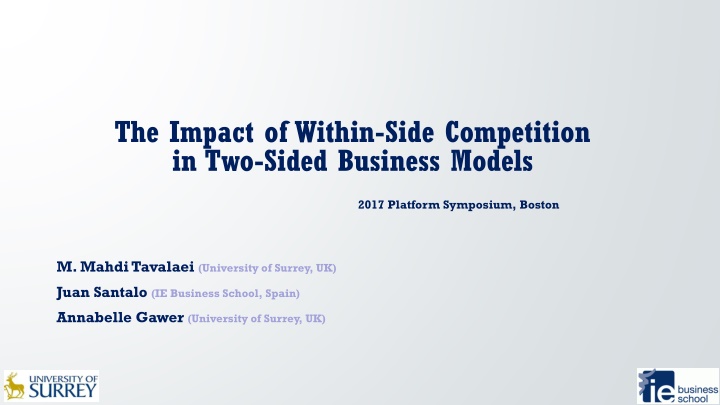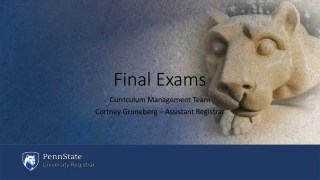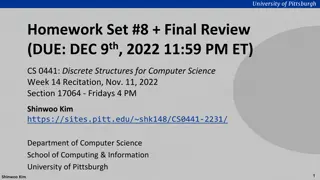
Impact of Within-Side Competition in Two-Sided Business Models
Explore the impact of within-side competition in two-sided business models at the 2017 Platform Symposium. Learn about indirect network effects, cross-subsidization strategies, and the research question on how platform business models affect firm performance in response to a change in the competitive environment within the airport industry.
Uploaded on | 0 Views
Download Presentation

Please find below an Image/Link to download the presentation.
The content on the website is provided AS IS for your information and personal use only. It may not be sold, licensed, or shared on other websites without obtaining consent from the author. If you encounter any issues during the download, it is possible that the publisher has removed the file from their server.
You are allowed to download the files provided on this website for personal or commercial use, subject to the condition that they are used lawfully. All files are the property of their respective owners.
The content on the website is provided AS IS for your information and personal use only. It may not be sold, licensed, or shared on other websites without obtaining consent from the author.
E N D
Presentation Transcript
The Impact of Within-Side Competition in Two-Sided Business Models 2017 Platform Symposium, Boston M. MahdiTavalaei (University of Surrey, UK) Juan Santalo (IE Business School, Spain) Annabelle Gawer (University of Surrey, UK)
Two-Sided Platforms Sellers Game publishers App developers Merchants Advertisers Retailers e-Commerce portals Video game consoles Operating Systems Payment Cards Yellow Pages Shopping Malls Buyers Gamers Users Consumers Readers Shoppers Two-sided platforms creates value by connecting two distinct groups (sides) that are subject to cross-side network effects 2
Indirect Network Effects Lead to Cross-Subsidization Strategy The utility of agents on one side depends on the number of agents on other sides; (Positive) indirect network effect = Cross-side network externalities (Armstrong, 2006; Rochet & Tirole 2003, 2006) Divide-and-conquer pricing strategy Incentivize (subsidize) one side & Extract extra utility from other side (monetize) Internalizing the externalities between the two sides (Belleflamme & Peitz, 2010; Caillaud & Jullien, 2003; Rochet & Tirole, 2003, 2006) 3
Research Question QUESTION: Do platform business models affect firm performance, when responding to a change in the competitive environment? This is a hard problem to study empirically: As generally, firms that operate platform vs non-platform business models often belong to different industries and have fundamentally different characteristics, which make them NOT-COMPARABLE WHAT WE DO: We find an industry where firms with platform business models co-exist with non-platforms We take advantage of a quasi-experiment: A change in regulation (exogenous shock) which affects both types We study the impact of a change in competitive environment (increasing competition within one side) on: Similar firm s (in the same market) performance and response (pricing strategy), The only difference between firms: whether they had adopted a two-sided business model or not. 4
Empirical Context Airport Industry Focal firms = airports Rent commercial space Use aeronautical services Commercial retailers care more about the presence of airlines than vice versa. Both groups are subject to competition/congestion effects. (Armstrong, 2007; Gillen, 2011) Buy ticket Some airports adopt a platform business model, while others do not Buy commercial products 5
Airports: Commercial side Revenue and Airside Revenue Airports revenue from retail = Max (% royalty of retail sales; minimum Annual Guarantee) 6
Platform vs. Non-Platform Airports Two pricing approaches for setting price for airlines Residual Compensatory Airside Operating Expenses =Airport expenses due to airline use and operation of airport facilities A A Commercial Side Revenue =Airport net revenue coming from Commercial Side B B Airside Price =Price that airports charge airlines function(A-B) function(A) 1. Some airports adopt Residual pricing : Airports have a unique profit and loss account. There is cross subsidization. (Signatory) Airlines are subsidized by revenue from retailers THIS MAKES THEM PLATORM AIRPORTS 2. Other airports adopt Compensatory pricing : Airports have two separate profit and loss accounts. There is no cross subsidization. Two separate profit functions to be maximized. (e.g., Doganis, 2005; Forsyth, 2004) THIS MAKES THEM NON-PLATORM AIRPORTS Residual = Platform Business Model Compensatory = Non-Platform Business Model 7
Empirical Context Airports Rent commercial space Use aeronautical services Only in platform airports ( Residual ) : Airlines are subsidized by the retailer side Commercial retailers are the monetized side Buy tickets subsidized monetized Buy commercial products 8
Airline Subsidization: Anecdotal Evidence If the nonairline revenues are high in a given year, the landing fee for the airlines may be quite low. In recent years, several airports including Los Angeles and Honolulu International have approached a negative landing fee." (Airport System Development; Washington, D. C.: U.S. Congress, Office of Technology Assessment, OTA-STI-231, August 1984) "At the busiest residual airports, airline fees can be exceptionally low. In 1999, for example, Honolulu charged no landing fee because the residual covered all airfield costs! (de Neufville & Odoni, 2003) 9
Exogenous Shock: AIR-21, a Regulation that Increases Competition within Airside Wendell H. Ford Aviation Investment and Reform Act for the Twenty -First Century (AIR-21) Enacted in year 2001 Mandated covered airports to diminish entry barriers for new airlines and foster within-airport competition among airlines. Coverage criteria: 1) account for more than 0.25 percent of enplanements at U.S. primary airports (large & medium hubs) 2) are highly concentrated by a few airlines (controlling more than 50 percent of traffic by two airlines) Snider & Williams (2014) report that AIR-21 significantly decreased airline fares on routes linked to the covered airport. 10
What the paper does Airport financial performance Increase of intragroup competition among airlines (due to AIR-21) Price charged to commercial retailers (COMMERCIAL SIDE) For platform vs. non-platform airports 11
How AIR-21 could affect Demand from Airside, and Effect on Commercial side Entry to Airside AIR-21 Revenue from Commercial Side Will passengers spend more, or less, in retail? Depends on: number of passengers composition of passengers 12
How AIR-21 could have affected Demand from Airside and Effect on Commercial side Decreases Airport Performance Depends on: number of passengers composition of passengers Will Entry to Airside passengers spend more, or less, in retail? AIR-21 Within-Side Airline competition Diminished Revenue from Commercial Side Low-cost passengers spend less on retail Increases rivalry among incumbent airlines Could lead to incumbent legacy airlines closing routes or defecting to other airports, and substitutive entry from Low-Cost airlines 13
How platform airports avoided this scenario Increases Airport Performance Entry to Airside Non-Low-Cost passengers spend more in retail AIR-21 Within-Side Airline Competition Airports increase price in Commercial Side Airport subsidizes signatory legacy (non- Low-Cost) airlines Increases rivalry among incumbent airlines Diminished Price in Airside for Signatory Airlines Could lead to incumbent legacy airlines defecting to other airports, or closing routes, and substitutive entry from Low- Cross- Encourages incumbent legacy airlines to remain, and encourages new legacy airlines to sign in, while Low- Cost airlines exit Cost airlines Subsidization 14
Hypotheses H1. When intragroup competition increases in the airside, only airports with a platform business model can increase their financial performance. H2. Higher intragroup competition in the airside increases the price for retailers on the commercial side, if they have a platform business model. 15
Data, Method and Variables 66 U.S. airports (all medium and large hubs) for years 1996-2005 Diff-in-Diff model applying AIR-21 regulatory shock at 2001 43 covered(treated) vs. 23 non-covered(control) airports (Snider & Williams, 2014) DVs Performance: Operating income per passenger AND Operating ROS (from FAA) Commercial side price: Airport s Commercial (in-terminal) revenue per passenger (from FAA) Airside price: Airport s Landing revenue per passenger (from FAA) IVs AIR-21 intervention: covered/non-covered airports , pre/post regulation dummies (Treat Post) Airports business model: residual vs. compensatory pricing approach (from ACI-NA) CVs Number of airport owners that serve the same city market (from DOT) LCC penetration (from DOT) Average Ticket price (from DOT) Hub status (from FAA) Metropolitan income per capita (from BSA) 16
Effect of AIR-21 on Airport Performance (Diff-in-Diff): H1 H1 H1 18
Evidence for number of low-cost airlines goes up in non-platform airports 20
Evidence for percentage of non-low-cost passengers goes up in platform airports Passengers flying with low-cost airlines spend less in terminals (Castillo-Manzano, 2010). 21
Additional Robustness Tests Regression Discontinuity Design (to deal with the concern about homogeneity of treated vs. control groups) Placebo analysis (to be sure about the exogeneity of the shock) Alternative Measure for Price in Commercial Side (real percentage of the sale that retailers pay to the airport as commercial price, from a subsample of contracts between airport and retailers) Testing for possibility of manipulation for being in control or treated groups Testing the potential cofounding effect of Sept. 11th 2001 terroristic attack More in progress! 22
Conclusion Airport financial performance goes up Increase of intragroup competition among airlines (due to AIR-21) Price charged to commercial retailers goes up Only for platform airports 23
Specificity of the empirical context The results crucially depend on the heterogeneity within the airline side Not all members of this side are equally valuable to the members of the other side The platform offers two types of contracts (affiliation) to the airline side members Self-selection from less-valuable side members (here, the low-cost airlines) who opt out of platform-airport signatory agreements This introduces boundary conditions to our conclusions But this can be found in many platforms, so it highlights a useful mechanism It is also a contribution, as it highlights the importance of types of members within one side 24
Contributions First study (to our knowledge) that investigates differences in response/outcome to competitive change in the environment for platform vs. non-platform business models, in the same industry. Among first empirical studies that study airports from two-sided market perspective which is called for more studies (Gillen, 2011). Highlights the importance of heterogeneity within one side (i.e., how a portion of one side members are valued differently by the other side members) on the effect on the platform performance 25
Thank You! 26
U.S. Airports & Profit Seeking Behavior Despite public governance in most of the U.S., their services and financing, they extensively collaborate with the private sector for cost efficiency and service quality objectives. In fact, the government body that owns a U.S. airport often employs only about ten to twenty percentage of the workforce active at the airport. 1) Since U.S. carriers face a very competitive market, they act as a force to push airports toward efficiency and profitability goals. Many airports in the United States, have in recent years begun to be organized as quasi-privatized airport authorities 2) [T]his has been driven by the FAA s need for airports to be self-sustaining . [A]lthough social welfare is their fundamental objective, they recognize all other objectives hinge on their ability to invest and grow (Bailey, 2002; Carney and Mew, 2003; de Neufville, 1999) It is quite reasonable to assume that U.S. airports pursue profitability (Gillen and Lall, 1997, Marris, 1963) 28
Airport Financing Sources Fuhr & Beckers, 2009 29



















